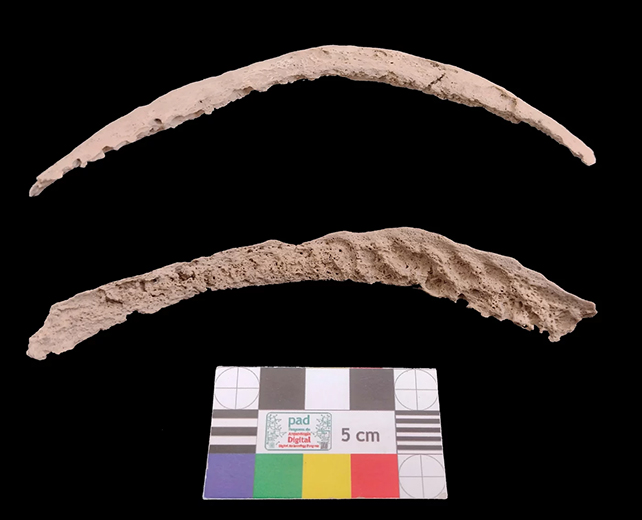Study Confirms: Syphilis Was Active in The Americas Long Before Columbus
Health04 January 2025
 (Hutchyb/E+/Getty Images)
(Hutchyb/E+/Getty Images)The history of syphilis has long been debated, with experts unable to come to a consensus over the origins of the outbreak that rocked Europe in the 16th century.
New research reveals the bacterium responsible for the sexually transmitted epidemic was active and diverse in the Americas long before Colombus's voyage is hypothesized to have exported it back to the Old World.
For decades, two models have dominated: the Columbian hypothesis (syphilis came to Europe from America), and the pre-Columbian hypothesis (syphilis was already in Europe before America was discovered).
Here, an international team of researchers analyzed ancient bone samples from across the Americas – some dating back as far as the 13th century – to look for genetic evidence of Treponema pallidum, the bacterium behind syphilis and other related diseases.
New research reveals the bacterium responsible for the sexually transmitted epidemic was active and diverse in the Americas long before Colombus's voyage is hypothesized to have exported it back to the Old World.
For decades, two models have dominated: the Columbian hypothesis (syphilis came to Europe from America), and the pre-Columbian hypothesis (syphilis was already in Europe before America was discovered).
Here, an international team of researchers analyzed ancient bone samples from across the Americas – some dating back as far as the 13th century – to look for genetic evidence of Treponema pallidum, the bacterium behind syphilis and other related diseases.

"Several genomes from the syphilis family have been reconstructed from archaeological bone, but these haven't been able to address core questions related to the pre or post-Columbian theories surrounding syphilis," says paleopathologist Kirsten Bos, from the Max Planck Institute for Evolutionary Anthropology in Germany.
Through a variety of delicate techniques including DNA extraction and genome sequencing, the researchers found a deep history and diversity for T. pallidum, across Mexico, Chile, Peru, and Argentina.
Through comparisons with modern strains of the bacteria, it seems likely that it originated from these regions across thousands of years, eventually giving rise to syphilis and other related diseases. It's a strong case for the Columbian hypothesis.
It seems syphilis became more virulent at some point before Columbus arrived – and then at the end of the 15th century, as settlers started returning to Europe, it set off the so-called Great Pox explosion of the disease that swept across the continent and left widespread death and disfigurement in its wake.
"The data clearly support a root in the Americas for syphilis and its known relatives, and their introduction to Europe starting in the late 15th century is most consistent with the data," says Bos.
Together with the related yaws, pinta, and bejel, syphilis is in a small group of conditions known as treponemal diseases. This research backs up the idea that these diseases are the modern-day results of ancient pathogens circulating in the Americas.
Syphilis-like bone lesions have been spotted on European skeletons dating back to before 1492, but it's not clear if they were actually caused by syphilis – something more advanced DNA analysis technologies could determine with greater confidence.
It also could yet be possible that different forms of syphilis have been rippling through diverse pockets of humanity throughout much of our history.
While prior existence of the pathogen in Europe can't be ruled out, however, the timing and demonstration of the disease makes the Colombian connection to the Great Pox all the more solid.
The researchers suggest that more comprehensive studies – across the Americas, Europe, and Africa – will be able to pin down the emergence of syphilis and what came before it, giving us fresh insight into one of the most significant diseases in history.
"The search will continue to define these earlier forms, and ancient DNA will surely be a valuable resource," says biochemist Johannes Krause, from the Max Planck Institute for Evolutionary Anthropology.
"Who knows what older related diseases made it around the world in humans or other animals before the syphilis family appeared?"
Through a variety of delicate techniques including DNA extraction and genome sequencing, the researchers found a deep history and diversity for T. pallidum, across Mexico, Chile, Peru, and Argentina.
Through comparisons with modern strains of the bacteria, it seems likely that it originated from these regions across thousands of years, eventually giving rise to syphilis and other related diseases. It's a strong case for the Columbian hypothesis.
It seems syphilis became more virulent at some point before Columbus arrived – and then at the end of the 15th century, as settlers started returning to Europe, it set off the so-called Great Pox explosion of the disease that swept across the continent and left widespread death and disfigurement in its wake.
"The data clearly support a root in the Americas for syphilis and its known relatives, and their introduction to Europe starting in the late 15th century is most consistent with the data," says Bos.
Together with the related yaws, pinta, and bejel, syphilis is in a small group of conditions known as treponemal diseases. This research backs up the idea that these diseases are the modern-day results of ancient pathogens circulating in the Americas.
Syphilis-like bone lesions have been spotted on European skeletons dating back to before 1492, but it's not clear if they were actually caused by syphilis – something more advanced DNA analysis technologies could determine with greater confidence.
It also could yet be possible that different forms of syphilis have been rippling through diverse pockets of humanity throughout much of our history.
While prior existence of the pathogen in Europe can't be ruled out, however, the timing and demonstration of the disease makes the Colombian connection to the Great Pox all the more solid.
The researchers suggest that more comprehensive studies – across the Americas, Europe, and Africa – will be able to pin down the emergence of syphilis and what came before it, giving us fresh insight into one of the most significant diseases in history.
"The search will continue to define these earlier forms, and ancient DNA will surely be a valuable resource," says biochemist Johannes Krause, from the Max Planck Institute for Evolutionary Anthropology.
"Who knows what older related diseases made it around the world in humans or other animals before the syphilis family appeared?"
The research has been published in Nature.


No comments:
Post a Comment